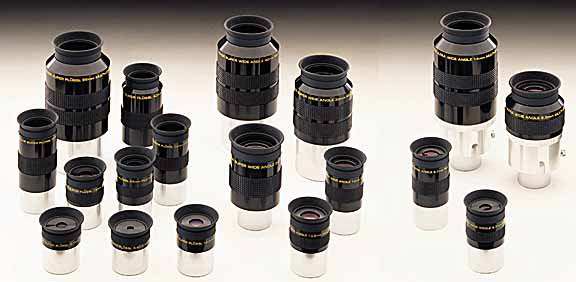Beginner's Guide
Eyepieces In Depth
Interchangeable eyepieces are one of the two ways that make telescopes different from binoculars. The other being binoculars are simply a pair of identical small telescopes. Here we go in depth of what you really need to know plus what's in the category of "nice to know."
So Many Eyepieces!
Why are there so many different eyepieces? Basically it's function and of course price always plays a part. As we've already shown the single most important specification of an eyepiece is its focal length because that will determine the magnification of your telescope view. To the beginner that's all they really need to know, but there is so much more.
Magnification / Focal Length
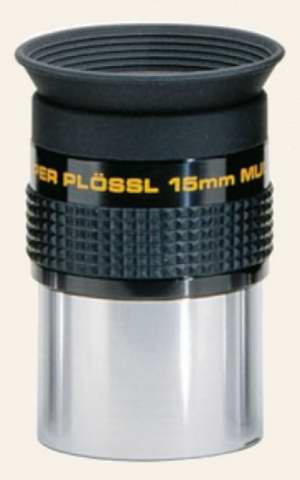 The eyepiece will determine the magnification. Simple enough. The eyepiece magnifies the image that is formed from the objective lens
of a telescope. How much will any given eyepiece magnify? On every commercial eyepiece a number will be imprinted
like the example on the left followed my the letters "mm" which
stand for millimeters. This is
the focal length of that eyepiece. Often, but not always the type of eyepiece will be shown. In the example it is Plössl. We will
discuss the various eyepiece types further down.
The eyepiece will determine the magnification. Simple enough. The eyepiece magnifies the image that is formed from the objective lens
of a telescope. How much will any given eyepiece magnify? On every commercial eyepiece a number will be imprinted
like the example on the left followed my the letters "mm" which
stand for millimeters. This is
the focal length of that eyepiece. Often, but not always the type of eyepiece will be shown. In the example it is Plössl. We will
discuss the various eyepiece types further down.
To calculate the magnification of any given eyepiece, you simply take the focal length of the telescope and divide it by the focal length of the eyepiece. So for a telescope with a 1200mm focal length, that 15mm eyepiece will give a magnification of 80X.
1200mm ÷ 15mm = 80
Field of View
After an eyepiece's focal length, the most important feature is the apparent field of view (FOV). All FOVs are not the same. In the cheapest eyepieces apparent FOV can be as small as 30°. The widest ones are over 90°. In fact those extremely wide ones are so large you have to actually look around to take in the entire field.

The left and center images above are magnified exactly the same. The difference is the left one has a much larger apparent FOV. The right image shows the same apparent FOV as the left, but the magnification is much more. Of course this immediately begs the question: why would you ever buy an eyepiece with a smaller field of view? The simple answer is price because wide field eyepieces have more glass elements and are therefore more difficult to manufacture. You will see this in detail when we discuss the various eyepiece types.
Barrel Diameter
Eyepieces for your telescope basically come in just two sizes, but several other standard sizes do exist. All eyepieces are threaded at the bottom in order to accommodate filters.
- 1.25" - This is by far the most common barrel diameter. The practical upper limit on focal lengths for this barrel size is about 32 mm. The reason is 1.25" is about 32mm so the barrel itself becomes the field stop (we'll explain this later). But you will find 1.25" eyepieces larger than 32mm (40mm is fairly common), but the field of view suffers. These eyepieces are threaded for 30mm filters.
- 2" - These eyepieces exist to overcome that 32mm upper limit on the field stop and their effective limit is about 55mm. Therefore,
you will see larger focal length eyepieces in this size. But there are ramifications:
- You need a 2" focuser on your telescope. And because you'll undoubtably need to use 1.25" eyepieces, you'll need an adapter.
- These eyepieces tend to be expensive because long focal length eyepieces require more glass.
- These eyepieces can be expensive to very expensive.
- If you need a filter, your 30mm filters for your 1.25" eyepieces won't work. You need 44mm filters.
- 0.965" - You can basically ignore this barrel diameter. It apparently is still out there, but they were used for "toy" and "department store" telescopes. They were generally of low quality and good eyepieces like Orthoscopic and Plössl were not available. And, obviously, they won't fit in your 1.25" or 2" focuser without an adapter.
- 2.7" and 3" - These eyepieces are naturally uncommon and considered specialty items. Their purpose is to allow a very wide field stop for very large focal length eyepieces which can allow apparent FOVs up to 120°! They are heavy and can create substantial balancing problems. But 3" focusers are becoming more popular because of digital imaging and use of smaller eyepiece barrels is accomplished by simple and fairly cheap adapters.
Mechanics of an Eyepiece
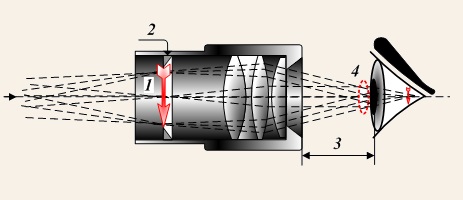
To really understand why there are so many different eyepieces available, even with the same focal length, you need to learn how they work.
The diagram at the right shows the light rays from the objective lens and what happens with the eyepiece.
- The focal point of the objective lens. Here we're showing a downward red arrow as the image formed. So the red arrow was pointing upwards at the source. You can see a tiny downward red arrow is formed on the eye's retina at the right.
- The field stop. It is an obstruction that limits the area of the image or the amount of light from the telescope system. Normally it is coincident with the focal plane of the objective and defines the image diameter. It is usually a diaphragm within the eyepiece barrel, but can be the barrel itself can function as the field stop. It therefore controls the apparent field of view and it limits aberrations that would otherwise appear with an increase in field width.
-
Eye relief. This is the distance the eye needs to be held behind the eye lens of an eyepiece to see images properly through it.
A larger relief usually means it is more more comfortable viewing position. However, it can be uncomfortable if it is too long as you
have a harder time keeping your eye in the right position. This can be overcome with eye cups to help aid the observer.
Typically eye relief varies between 2mm and 20mm depending on the eyepiece. Long focal length eyepieces generally have good eye relief, but short ones can be problematic. Not so much if the focal length of the objective is long (f/8 and over), but telescopes today typically have shorter focal lengths so they need the newer more exotic eyepiece designs. -
Exit pupil. This is the circle of light coming out of the eyepiece. It is measured by the diameter of the light cone and it should not be over
7mm because a totally dark adapted pupil is about 7mm. But as you grow older this value lessens to about 5mm.
Click/Tap here to see the
discussion of Exit Pupil on Wikipedia. If the cone of light is greater than
your pupil dialation, your pupil effectively becomes an aperture stop, meaning it's as if you're using a telescope with a smaller objective lens.
The exit pupil for a given eyepiece is easily calculated. You simply take the focal length of the eyepiece and divide it by the focal ratio of the telescope. For example, for a 20mm eyepiece on an f/5 telescope (regardless of the aperture size), the exit pupil would be 4mm.20mm ÷ 5 = 4mm
Eyepiece Types
Here we list many of the eyepiece types, but please take the following notes. First of all, you can reasonably ignore a lot of the simpler ones because you'd have difficultly buying them because they're not manufactured. Even some of the more complex ones are now considered practically obsolete, much of it due to modern telescopes coming (in general) much shorter focal lengths which makes them much smaller and lighter. On the other end of the spectrum are the really exotic models with 6+ lens segments. They are both heavy and expensive. This type has proliferated because of the shorter focal length telescopes and the fact that new eyepieces can be designed via computer software where they can not only be designed, they can be virtually tested.
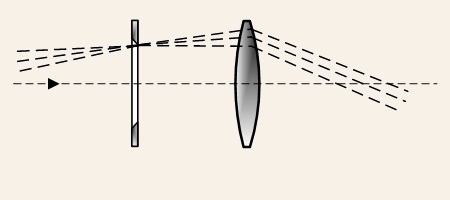 Convex Lens. This is one of two designs that are the simplest
eyepieces as it is a single lens.
Convex Lens. This is one of two designs that are the simplest
eyepieces as it is a single lens.
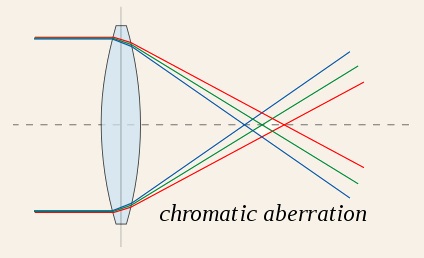 It was probably the very first eyepiece
lens used in the early 1600's when the telescope was invented in the Netherlands. The huge problem with this design is chromatic aberration, also
known as color fringing. They only really work with extremely long focal length telescopes which are simply impractical because the tube would
be unacceptable long. Consequently you're not going to find commercially made eyepieces with this design.
It was probably the very first eyepiece
lens used in the early 1600's when the telescope was invented in the Netherlands. The huge problem with this design is chromatic aberration, also
known as color fringing. They only really work with extremely long focal length telescopes which are simply impractical because the tube would
be unacceptable long. Consequently you're not going to find commercially made eyepieces with this design.
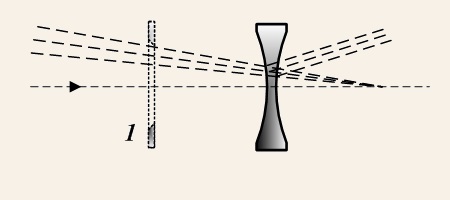 Negative / Galilean Lens. This is the other simple eyepiece design as it is also a single lens. It was also one of the earliest designs
and gets the Galilean Lens label because it was used in Galileo Galilei's 1609 telescope design. It only produces a very narrow field of view, but
it does produce an upright image. Consequently it was used in early binoculars and opera glasses.
Negative / Galilean Lens. This is the other simple eyepiece design as it is also a single lens. It was also one of the earliest designs
and gets the Galilean Lens label because it was used in Galileo Galilei's 1609 telescope design. It only produces a very narrow field of view, but
it does produce an upright image. Consequently it was used in early binoculars and opera glasses.
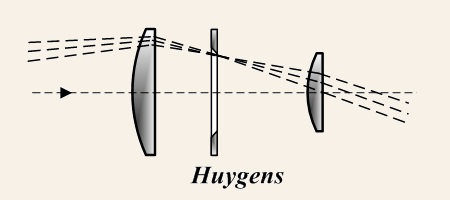 Huygens. This was the first multiple lens eyepiece design. It consists of two plano-convex lenses with the plane sides toward the eye.
Developed about 1660 by Christiaan Huygens who discovered by using two air
spaced convex lens with the proper spacing there was no transverse chromatic aberration. The leading lens is called the field lens and the
other the eye-lens.
Though the design works okay with relatively long
focal length objectives (f/10 and over), with shorter focal lengths it doesn't work well. And the apparent FOV is only 40°.
Huygens. This was the first multiple lens eyepiece design. It consists of two plano-convex lenses with the plane sides toward the eye.
Developed about 1660 by Christiaan Huygens who discovered by using two air
spaced convex lens with the proper spacing there was no transverse chromatic aberration. The leading lens is called the field lens and the
other the eye-lens.
Though the design works okay with relatively long
focal length objectives (f/10 and over), with shorter focal lengths it doesn't work well. And the apparent FOV is only 40°.
One unique aspect of this eyepiece design is that the focal plane lies between the two lenses. Consequently this eyepiece cannot be used as a magnifier. Another almost unique feature is it can be used for solar projection for extended periods of time because the two lenses are not cemented together as they are in other designs. Heat will generally melt the cement rendering an eyepiece nearly useless.
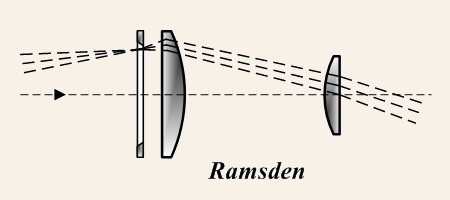 Ramsden. This was the second multiple lens eyepiece. Designed by Jesse Ramsden in 1782, it is very similar in design to the Huygens as it
also has two air spaced lenses. The spacing is less than one eye-lens focal length apart, typically 7-8/10ths of the focal length of the eye-lens.
A separation of 1 focal length would never be used because any dust on the lens will be in focus. The apparent FOV is 40°. But
the Ramsden is only slightly better than
a Huygens and not widely manufactured anymore for telescopes.
Ramsden. This was the second multiple lens eyepiece. Designed by Jesse Ramsden in 1782, it is very similar in design to the Huygens as it
also has two air spaced lenses. The spacing is less than one eye-lens focal length apart, typically 7-8/10ths of the focal length of the eye-lens.
A separation of 1 focal length would never be used because any dust on the lens will be in focus. The apparent FOV is 40°. But
the Ramsden is only slightly better than
a Huygens and not widely manufactured anymore for telescopes.
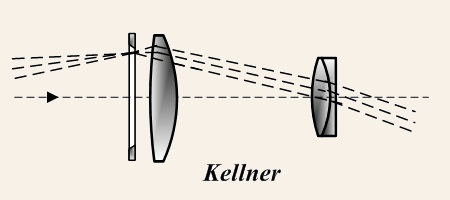 Kellner. A Kellner eyepiece is really the Ramsden design with the inclusion of corrective achromatic doublet. It was developed by Carl Kellner
back in 1849 and was the first achromatic eyepiece. These are still readily available and popular particularly because of their relative low cost, but
they also perform fairly well in low to medium power with telescopes of f/6 and longer. They are superior to either the Huygens or Ramsden designs.
They typically have an apparent FOV of 40-50°.
Kellner. A Kellner eyepiece is really the Ramsden design with the inclusion of corrective achromatic doublet. It was developed by Carl Kellner
back in 1849 and was the first achromatic eyepiece. These are still readily available and popular particularly because of their relative low cost, but
they also perform fairly well in low to medium power with telescopes of f/6 and longer. They are superior to either the Huygens or Ramsden designs.
They typically have an apparent FOV of 40-50°.
One shortcoming of this design (and all doublets and triplets) is internal reflections. This has been overcome with the use of anti-reflection coatings. We believe all modern eyepieces automatically come with anti-reflective codings.
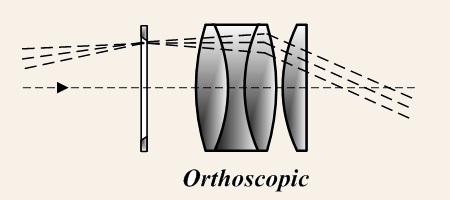 Orthoscopic. This was the first eyepiece design with a triplet component. Developed by Ernst Abbe in 1880, it was considered the high-end
of consumer eyepieces. It has almost perfect image quality and good eye relief. However, it has a fairly narrow apparent FOV at 40-45° so
they are mainly good for planetary viewing. The popularity of this eyepiece has waned
since anti-reflective codings have become the norm and the Plössl eyepiece
is now preferred.
Orthoscopic. This was the first eyepiece design with a triplet component. Developed by Ernst Abbe in 1880, it was considered the high-end
of consumer eyepieces. It has almost perfect image quality and good eye relief. However, it has a fairly narrow apparent FOV at 40-45° so
they are mainly good for planetary viewing. The popularity of this eyepiece has waned
since anti-reflective codings have become the norm and the Plössl eyepiece
is now preferred.
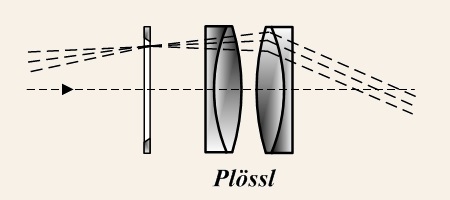 Plössl or Symmetrical. The Plössl has become one of the most popular eyepieces for amateurs. It was developed in
1860 by Georg Simon Plössl.
It is sometimes referred to as Symmetrical because the two doublets can be identical. The eyepiece overtook the Orthoscopic design when
anti-reflective codings became available as the Plössl has a good apparent FOV of 50° or more. Thus, it is good for both deep space and
planetary viewing. The big shortcoming of this design is short eye relief (limited to 70-80% of the eyepieces focal length). This becomes very
problematic when the focal length of the eyepiece is less than 10mm making the eye relief just 7-8mm. This makes viewing with eye glasses difficult.
Plössl or Symmetrical. The Plössl has become one of the most popular eyepieces for amateurs. It was developed in
1860 by Georg Simon Plössl.
It is sometimes referred to as Symmetrical because the two doublets can be identical. The eyepiece overtook the Orthoscopic design when
anti-reflective codings became available as the Plössl has a good apparent FOV of 50° or more. Thus, it is good for both deep space and
planetary viewing. The big shortcoming of this design is short eye relief (limited to 70-80% of the eyepieces focal length). This becomes very
problematic when the focal length of the eyepiece is less than 10mm making the eye relief just 7-8mm. This makes viewing with eye glasses difficult.
A word of caution, especially because these eyepieces are so popular. They are not easy to make plus the quality of the glass needed. Consequently, the quality of these eyepieces can vary considerably from one manufacturer to the next. Sometimes within the same manufacturer.
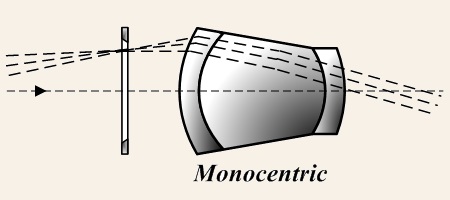 Monocentric. We add this eyepiece design almost as a footnote as it has become very rare. It is a achromatic triplet lens with two pieces
of crown glass cemented on either side of a flint glass element. It was invented by Hugo Adolf Steinheil and is given the name Monocentric because
it has a common center. The design is free from ghost reflections and shows a bright contrasty image which was a very desirable feature before
anti-reflective coatings became available. But it has a narrow field of view (about 25°) so only really used by planetary observers.
Monocentric. We add this eyepiece design almost as a footnote as it has become very rare. It is a achromatic triplet lens with two pieces
of crown glass cemented on either side of a flint glass element. It was invented by Hugo Adolf Steinheil and is given the name Monocentric because
it has a common center. The design is free from ghost reflections and shows a bright contrasty image which was a very desirable feature before
anti-reflective coatings became available. But it has a narrow field of view (about 25°) so only really used by planetary observers.
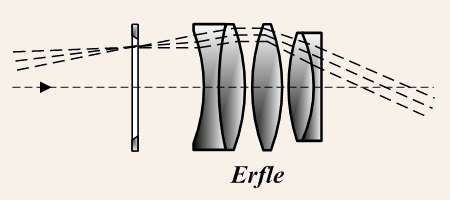 Erfle. The Erfle is a 5-element eyepiece developed during World War I for military purposes. It was patented in 1921 by Heinrich Erfle.
They were designed to have a wide field of view (60°) but only work well at low to medium powers. At high power they suffer from
astigmatism and ghost images. They offer a large eye lens and good eye relief. But they are now difficult to find because newer designs offer
wider fields of view.
Erfle. The Erfle is a 5-element eyepiece developed during World War I for military purposes. It was patented in 1921 by Heinrich Erfle.
They were designed to have a wide field of view (60°) but only work well at low to medium powers. At high power they suffer from
astigmatism and ghost images. They offer a large eye lens and good eye relief. But they are now difficult to find because newer designs offer
wider fields of view.
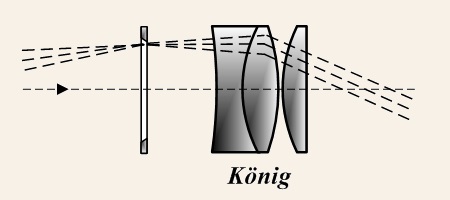 König. The König was designed in 1915 by Albert König, a German optician. It is essentially a simplified Orthoscopic.
The design allows for high power and very good eye relief. The apparent FOV is 55°. It has been largely replaced by the Plössl so
it is now a hard eyepiece to find.
König. The König was designed in 1915 by Albert König, a German optician. It is essentially a simplified Orthoscopic.
The design allows for high power and very good eye relief. The apparent FOV is 55°. It has been largely replaced by the Plössl so
it is now a hard eyepiece to find.
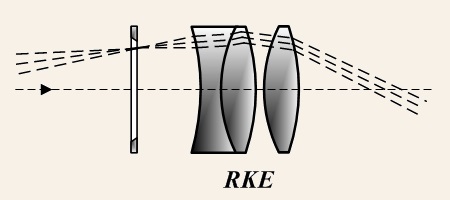 RKE. The RKE was designed by David Rank for Edmund Scientific who marketed this eyepiece. It is essentially a reverse adaptation
of the Kellner eyepiece, but provides a slightly larger apparent FOV. The RKE stands for either Rank Kellner Eyepiece or
Rank-Kaspereit-Erfle.
RKE. The RKE was designed by David Rank for Edmund Scientific who marketed this eyepiece. It is essentially a reverse adaptation
of the Kellner eyepiece, but provides a slightly larger apparent FOV. The RKE stands for either Rank Kellner Eyepiece or
Rank-Kaspereit-Erfle.
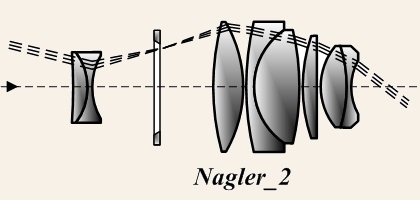
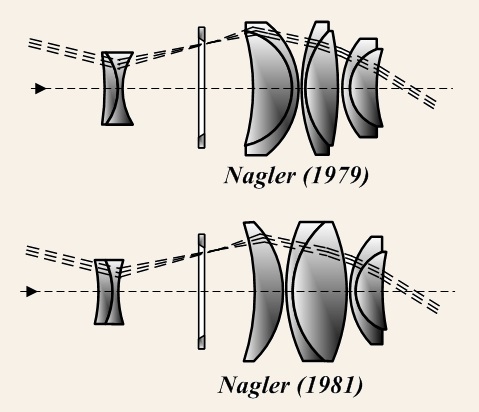
Nagler. This was the first of the new exotic eyepieces. They took having "multiple lens" eyepiece design to a whole new level.
The name comes from its inventor Albert Nagler, the founder of Tele Vue Optics. His first designs gave an apparent FOV of 82°! And did this
with good correction for astigmatism and other aberrations. These eyepieces have another huge advantage in that they perform especially
well with short focal length telescopes. If you look at the diagrams you'll notice that it's a design that has a built-in barlow (i.e., negative) lens.
So the positive lens series is not dealing with a really short cone of light. One consequence of this should not be an issue: the Nagler design
cannot be used as a standalone magnifier.
All of this comes at a double price. The first is their weight. The larger focal lengths when used on smaller telescopes will generally need rebalancing of the main telescope. The other one is the price itself. The cost of these eyepieces is understandably high and will generally cost more than the typical beginner's telescope. But those who purchase them are generally very satisified with their performance so feel it was money well spent.
Also, not surprising is these eyepiece designs have been copied so you have other choices in the so-called exotic eyepieces. But even within Tele Vue Optics, new designs are still being developed. The original Nagler design went on to Nagler Type-2, 3, 4, 5, and 6. They also have DeLite (62° with long ER), Panoptic (68°), Delos (72° with long ER), and finally, Ethos which have an apparent FOV of 100°.

